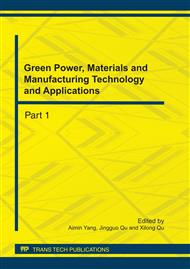p.42
p.47
p.53
p.58
p.64
p.69
p.74
p.81
p.86
Preparation of Corundum/Mullite Composites by Sintering
Abstract:
Mullite/corundum composites synthetized by sintering with bauxite as raw material was researched. The sintering temperature, main crystal phase, microstructure and fracture mode of the composites synthetized by sintering are different with change of ratio of Al2O3 and SiO2 and content of Al2O3: (1) If the ratio of Al2O3 and SiO2 and content of Al2O3 is low, sintering temperature of the composites is high, the main crystal phase is mullite, microstructure shows interlocking network structure formed by columnar mullite, the fracture mode of composites shows that mullite appears in the pulled out state; (2) If the ratio of Al2O3 and SiO2 content of Al2O3 is high, sintering temperature of the composites is low, the main crystal phase is corundum, microstructure shows the skeleton structure formed by granulous corundumthe, the fracture mode of composites shows intergranular fracture formed by corundum, occasionally transcrystalline fracture. The major reason of different sintering temperature of the composites is concerned with mullitization degree and content of glass phase.
Info:
Periodical:
Pages:
64-68
Citation:
Online since:
August 2011
Authors:
Keywords:
Price:
Сopyright:
© 2011 Trans Tech Publications Ltd. All Rights Reserved
Share:
Citation:


